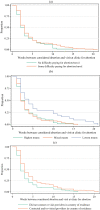Barriers and delays in access to abortion care: a cross-sectional study of people traveling to obtain care in England and the Netherlands from European countries where abortion is legal on broad grounds
- PMID: 38221617
- PMCID: PMC10789034
- DOI: 10.1186/s12978-023-01729-2
Barriers and delays in access to abortion care: a cross-sectional study of people traveling to obtain care in England and the Netherlands from European countries where abortion is legal on broad grounds
Abstract
Introduction: This study characterized the extent to which (1) financial barriers and (2) abortion care-seeking within a person's country of residence were associated with delays in abortion access among those travelling to England and the Netherlands for abortion care from European countries where abortion is legal on broad grounds in the first trimester but where access past the first trimester is limited to specific circumstances.
Methodology: We drew on cross-sectional survey data collected at five abortion clinics in England and the Netherlands from 2017 to 2019 (n = 164). We assessed the relationship between difficulty paying for the abortion/travel, acute financial insecurity, and in-country care seeking on delays to abortion using multivariable discrete-time hazards models.
Results: Participants who reported facing both difficulty paying for the abortion procedure and/or travel and difficulty covering basic living costs in the last month reported longer delays in accessing care than those who had no financial difficulty (adjusted hazard odds ratio: 0.39 95% CI 0.21-0.74). This group delayed paying other expenses (39%) or sold something of value (13%) to fund their abortion, resulting in ~ 60% of those with financial difficulty reporting it took them over a week to raise the funds needed for their abortion. Having contacted or visited an abortion provider in the country of residence was associated with delays in presenting abroad for an abortion.
Discussion: These findings point to inequities in access to timely abortion care based on socioeconomic status. Legal time limits on abortion may intersect with individuals' interactions with the health care system to delay care.
Keywords: Abortion; Delays; Europe; Financial barriers; Health system barriers; Travel.
Plain language summary
This paper explores delays in accessing abortion care associated with financial and medical system barriers. We focus on residents of countries in Europe where abortion is available on broad grounds in the first trimester seeking abortion care outside of their country of residence. This study demonstrates an association between difficulty covering abortion costs for people facing financial insecurity and in-country care seeking and delays in accessing abortion abroad. Policy barriers, medical system barriers, as well as financial barriers may interact to delay access to care for people in European countries with broad grounds for abortion access in the first trimester but restrictions thereafter, especially for people later in pregnancy.
© 2024. The Author(s).
Conflict of interest statement
The authors declare that they have no competing interests.
Figures


Similar articles
-
Cross-country abortion travel to England and Wales: results from a cross-sectional survey exploring people's experiences crossing borders to obtain care.Reprod Health. 2021 May 22;18(1):103. doi: 10.1186/s12978-021-01158-z. Reprod Health. 2021. PMID: 34022888 Free PMC article.
-
Gestational age limits for abortion and cross-border reproductive care in Europe: a mixed-methods study.BJOG. 2021 Apr;128(5):838-845. doi: 10.1111/1471-0528.16534. Epub 2020 Oct 23. BJOG. 2021. PMID: 32975864 Free PMC article.
-
Experiences of women who travel to England for abortions: an exploratory pilot study.Eur J Contracept Reprod Health Care. 2016 Oct;21(5):401-7. doi: 10.1080/13625187.2016.1217325. Epub 2016 Aug 19. Eur J Contracept Reprod Health Care. 2016. PMID: 27539129
-
Access to and sustainability of abortion services: a systematic review and meta-analysis for the National Institute of Health and Care Excellence-new clinical guidelines for England.Hum Reprod Update. 2020 Nov 1;26(6):886-903. doi: 10.1093/humupd/dmaa026. Hum Reprod Update. 2020. PMID: 32712660
-
A review of abortion laws in Western-European countries. A cross-national comparison of legal developments between 1960 and 2010.Health Policy. 2014 Oct;118(1):95-104. doi: 10.1016/j.healthpol.2014.06.008. Epub 2014 Jul 7. Health Policy. 2014. PMID: 25059743 Review.
Cited by
-
Delays in seeking abortion and its determinants among reproductive-age women based on the Ethiopian Demographic and health survey.Heliyon. 2024 Sep 26;10(19):e38477. doi: 10.1016/j.heliyon.2024.e38477. eCollection 2024 Oct 15. Heliyon. 2024. PMID: 39430523 Free PMC article.
-
"It Makes It More Real to You": Abortion Attitudes Following Experience and Contact With Abortion.Perspect Sex Reprod Health. 2025 Jun;57(2):198-210. doi: 10.1111/psrh.70019. Epub 2025 Jun 18. Perspect Sex Reprod Health. 2025. PMID: 40534175 Free PMC article.
-
Expanding access to safe ambulatory manual vacuum aspiration abortion up to 14+6 weeks following Argentina's legal reform: an observational study in the public health sector.Reprod Health. 2025 May 24;22(1):91. doi: 10.1186/s12978-025-02036-8. Reprod Health. 2025. PMID: 40410790 Free PMC article.
References
MeSH terms
Grants and funding
LinkOut - more resources
Full Text Sources
Medical
Miscellaneous

